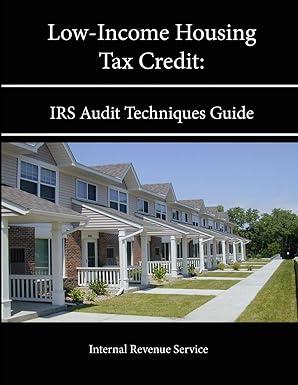Answered step by step
Verified Expert Solution
Question
1 Approved Answer
quick help dues in an hour Required information Problem 6-2AA Periodic: Alternative cost flows LO P3 [The following information applies to the questions displayed below)
quick help dues in an hour 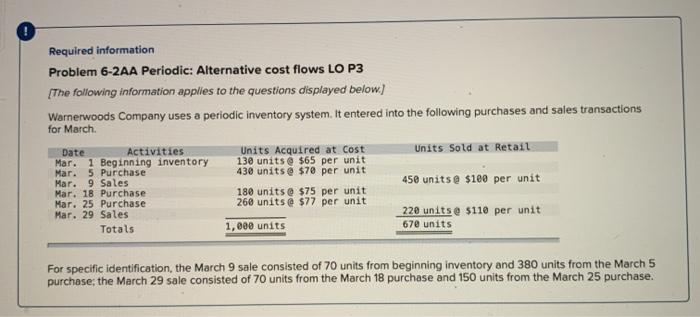
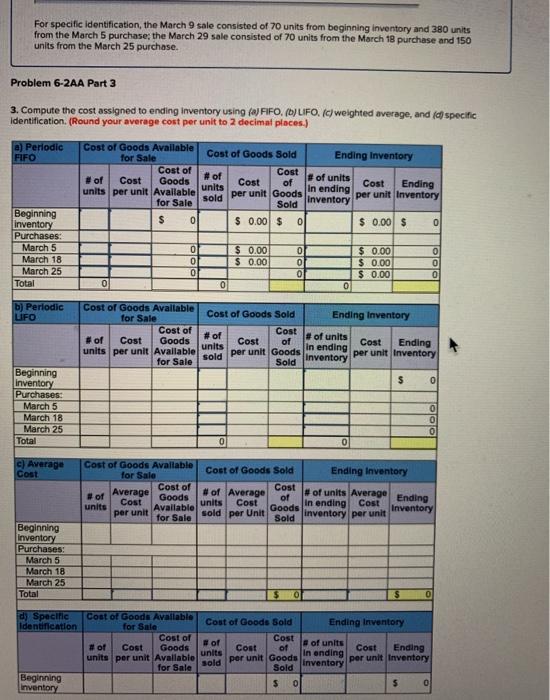
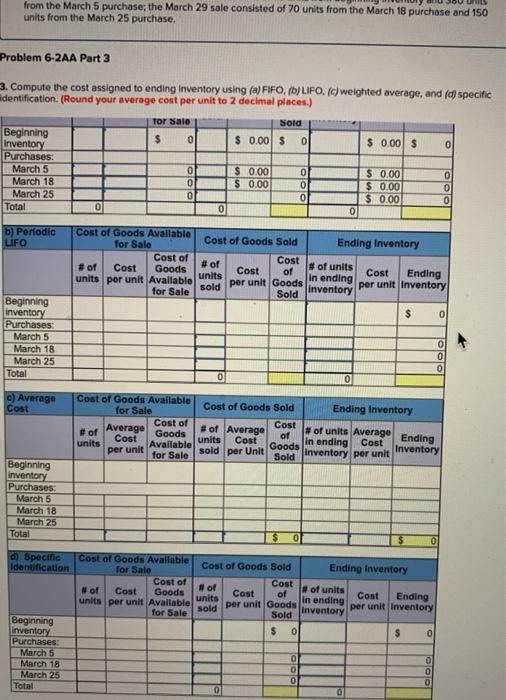
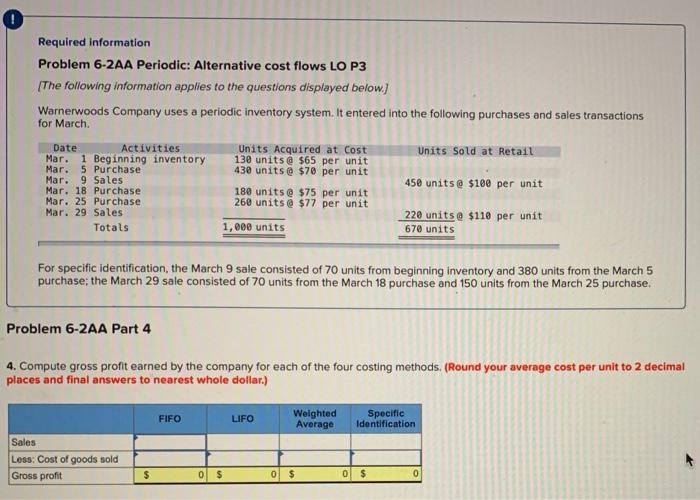
Required information Problem 6-2AA Periodic: Alternative cost flows LO P3 [The following information applies to the questions displayed below) Warnerwoods Company uses a periodic inventory system. It entered into the following purchases and sales transactions for March Date Activities Units Acquired at cost Units sold at Retail Mar. 1 Beginning inventory 130 units @ $65 per unit Mar. 5 Purchase 430 units@ $70 per unit Mar. 9 Sales 450 units@ $100 per unit Mar. 18 Purchase 180 units@ $75 per unit Mar. 25 Purchase 260 units@ $77 per unit Mar. 29 Sales 220 units @ $110 per unit Totals 1,000 units 670 units For specific identification, the March 9 sale consisted of 70 units from beginning inventory and 380 units from the March 5 purchase, the March 29 sale consisted of 70 units from the March 18 purchase and 150 units from the March 25 purchase. For specific identification, the March 9 sale consisted of 70 units from beginning inventory and 380 units from the March 5 purchase; the March 29 sale consisted of 70 units from the March 18 purchase and 150 units from the March 25 purchase. Problem 6-2AA Part 3 3. Compute the cost assigned to ending inventory using (a) FIFO. (b) LIFO. (c) weighted average, and (d) specific Identification, (Round your average cost per unit to 2 decimal places.) a) Periodic FIFO Cost of Goods Available for Sale Cost of Goods Sold Ending Inventory Cost of Cost # of Cost # of Goods Cost of #of units Cost units units per unit Available Ending In ending per unit Goods sold per unit Inventory for Sale Sold Inventory $ 0 $ 0.00 $ 0 $ 0.00 $ 0 Beginning Inventory Purchases: March 5 March 18 March 25 Total 0 0 0 $ 0.00 $ 0.00 0 0 0 $ 0.00 $ 0.00 $ 0.00 0 0 0 0 0 b) Periodic LIFO Cost of Goods Available for Sale Cost of Goods Sold Ending Inventory Cost of # of Cost #of Cost #of units Goods Cost of units Cost in ending Ending units per unit Available sold per unit Goods per unit Inventory for Sale Sold Inventory $ 0 Beginning Inventory Purchases: March 5 March 18 March 25 Total 0 0 0 0 0 c) Average Cost Cost of Goods Available Cost of Goods Sold for Sale Ending Inventory Cost of Cost of Average # of Average # of units Average Goods of Cost units Ending units Cost Available Goods in ending Cost Inventory for Sale sold per Unit Sold inventory per unit per unit Beginning Inventory Purchases: March 5 March 18 March 25 Total $ 0 $ 0 d) Specific Identification Cost of Goods Available for Sale Cost of # of Cost Goods units per unit Avallabio for Sale Cost of Goods Sold Ending Inventory of Cost Cost of units of Cost Ending units in ending sold per unit Goods per unit Inventory Sold Inventory $ 0 5 0 Beginning Inventory from the March 5 purchase, the March 29 sale consisted of 70 units from the March 18 purchase and 150 units from the March 25 purchase. Problem 6-2AA Part 3 3. Compute the cost assigned to ending Inventory using (a) FIFO, (b)LIFO. (c) weighted average, and (d) specific identification. (Round your average cost per unit to 2 decimal places.) Tor Sale Sold $ 0.00 $ 0 $ 0 $ 0.00 $ ol Beginning Inventory Purchases: March 5 March 18 March 25 Total 0 0 0 $ 0.00 $ 0.00 ololol $ 0.00 $ 0.00 $ 0.00 Q00 0 0 0 b) Periodic LIFO Cost of Goods Available Cost of Goods Sold for Sale Ending Inventory Cost of #of Cost # of Cost # of units Goods Cost units of Cost units per unit Available In ending Ending per unit Goods per unit Inventory for Sale Sold Inventory $ 0 sold Beginning inventory Purchases: March 5 March 18 March 25 Total 0 0 0 c) Average Cost Cost of Goods Available for Sale Cost of Goods Sold Ending Inventory Cost of # of Cost Average Goods # of Average of units Averago of Cost units Cost units Ending In onding Available Goods Cost per unit sold per Unit for Sale Inventory inventory per unit Sold Beginning Inventory Purchases: March 5 March 18 March 25 Total 0 $ 0 d) Specific Identification Cost of Goods Available for Sale Cost of of Cost Goods units per unit Available for Sale Cost of Goods Sold Ending Inventory # of Cost of units Cost of units Cost Ending in ending per unit Goods sold per unit Inventory Sold Inventory $ 0 s 0 Beginning Inventory Purchases March 5 March 18 March 25 Total 0 0 0 O 0 0 0 Required information Problem 6-2AA Periodic: Alternative cost flows LO P3 (The following information applies to the questions displayed below.) Warnerwoods Company uses a periodic inventory system. It entered into the following purchases and sales transactions for March Units Sold at Retail Date Activities Mar. 1 Beginning inventory Mar. 5 Purchase Mar. 9 Sales Mar. 18 Purchase Mar. 25 Purchase Mar. 29 Sales Totals Units Acquired at Cost 130 units @ $65 per unit 430 units@ $70 per unit 180 units @ $75 per unit 260 units@ $77 per unit 450 units@ $100 per unit 1,000 units 220 units@ $110 per unit 670 units For specific identification, the March 9 sale consisted of 70 units from beginning inventory and 380 units from the March 5 purchase; the March 29 sale consisted of 70 units from the March 18 purchase and 150 units from the March 25 purchase. Problem 6-2AA Part 4 4. Compute gross profit earned by the company for each of the four costing methods. (Round your average cost per unit to 2 decimal places and final answers to nearest whole dollar.) FIFO LIFO Weighted Average Specific Identification Sales Less: Cost of goods sold Gross profit $ 0 $ 0 $ 0 $ 0 



Step by Step Solution
There are 3 Steps involved in it
Step: 1

Get Instant Access to Expert-Tailored Solutions
See step-by-step solutions with expert insights and AI powered tools for academic success
Step: 2

Step: 3

Ace Your Homework with AI
Get the answers you need in no time with our AI-driven, step-by-step assistance
Get Started


